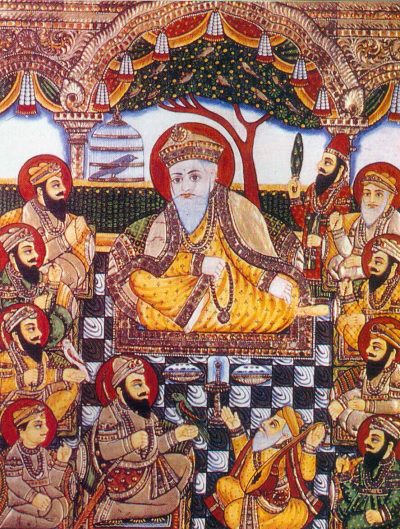Sikhism is one of the major faiths that sprung from the spiritually fertile land of India. A living faith for over five hundred years, the tradition believes in ten human Gurus starting from Guru Nanakji and ending with Guru Gobind Singhji. In the opinion of Professor Teja Singh, “The Guru stands for two things: Revelation of Truth through the Word, and the interpretation and practice of the Truth through Personal Guidance.”
This note and the accompanying visual aids are meant to provide the reader with a short introduction to the ten Sikh Gurus and their lasting impact on Indian culture and life.
Guru Nanak (1469-1539)
He was the First Guru and is regarded as the founder of the Sikh faith. Guru Nanakji referred to the Divine as ‘Ik Onkaar’ and gave the world the lofty ‘Mool Mantar’. He stated that god is One, Indivisible and Nirguna (without any attributes). He preached that there is no Hindu and no Musalmaan and debunked the caste system. Among his innumerable contributions, Guru Nanakji is also credited with establishing the first ‘dharamsaals’ (places of congregation to discuss dharma, pray and meditate). These dharamshalas developed into gurdwaras and the Kartarpur Gurdwara where he spent the last years of his life is regarded as the first gurdwara.
Guru Angad (1539-1552)
He was installed as the Second Guru by Guru Nanak Devji. Guru Angadji’s original name was ‘Lehna’. He created and introduced the Gurumukhi script in which the Adi Granth is written. He started the tradition of ‘akhaadas’ and expanded the institution of ‘langar’ (community kitchen).
Guru Amar Das (1552-1574)
The Third Guru, Guru Amar Dasji took up cudgels against the restrictions placed by the caste system and untouchability. He abolished the custom of purdah. He introduced new customs for birth and death ceremonies.
Guru Ram Das (1574-1581)
Guru ka Chak or Ram Das Pura (now the holy city of Amritsar in Punjab) which became the focal point for the Six tradition was founded by the Fourth Guru – Guru Ram Dasji.
Guru Arjan Dev (1581-1606)
The Fifth Guru compiled the Adi Granth and also completed the construction of Harmandir Sahib. He is the first martyr in the Sikh tradition as he was executed by the Mughal Emperor – Jehangir.
Guru Hargobind (1606-1644)
The Sixth Guru was the ‘Soldier Saint’ who took up arms to protect the Sikh faith. He erected the Akal Takhat (the Throne of the Eternal God) and established the two swords – Miri and Piri representing the spiritual and the secular domains.
Guru Har Rai (1644-1661)
The Seventh Guru devoted himself to furthering the teachings of Guru Nanakji and consolidating the Sikh faith. While Guru Har Raiji was essentially a peace-loving man, he did not disband the army formed by Guru Hargobindji.

Tanjore Style painting – probably 19th century CE
Wikimedia Commons
Guru Har Krishen (1661-1664)
The Eighth Guru was only five when he was installed. He was known as the ‘Bala Pir’ and while dying at the young age of nine, expressed his wish that ‘Baba Bakale’ be appointed as the next Guru.
Guru Teg Bahadur (1665-1675)
The Ninth Guru established the town of Anandpur (Haven of Bliss). Guru Tegh Bahadurji made the supreme sacrifice to protect the Hindus. He faced execution at the hand of the Mughal empire instead of converting and became a martyr. His son – Guru Gobind Singhji wrote the following about his shaheedi (martyrdom):
“Dharam het saka jin kiya,
Sirr diya par sirarr na diya.”
‘He was martyred for upholding Truth and Righteousness. He gave his head, but not his determination.’ (loosely paraphrased).
Guru Gobind Rai (1675-1708)
The Tenth Guru – Guru Gobind Singhji proclaimed that the Adi Granth would henceforth be the Guru for all Sikhs – ‘Guru manayo Granth’. He created the Khalsa and symbolises buoyant hope (carhdi kala). A true martyr, he was characterised by an indefatigable spirit to wage a war for Dharam (righteousness).
As per the instructions of Guru Gobind Singhji, the Sikh tradition has no more human Gurus. Guru Granth Sahibji is the eternal Guru.
References:
- Singh, Khazan (1914). History and Philosophy of the Sikh Religion – Volume I. Naval Kishore Press.
- Singh, Khushwant (2016). A History of the Sikhs – Volume I. Oxford University Press.
- Singh, Teja (1938). Sikhism – Its Ideals and Institutions. Longmans, Green & Co. Ltd.


An impressive share, I just given this onto a colleague who was doing just a little analysis on this. And he the truth is bought me breakfast as a result of I discovered it for him.. smile. So let me reword that: Thnx for the treat! But yeah Thnkx for spending the time to debate this, I really feel strongly about it and love reading more on this topic. If doable, as you change into expertise, would you thoughts updating your blog with more particulars? It’s extremely helpful for me. Huge thumb up for this weblog post!
Youre so cool! I dont suppose Ive read anything like this before. So nice to find somebody with some original thoughts on this subject. realy thank you for starting this up. this website is something that is needed on the web, someone with a little originality. useful job for bringing something new to the internet!
Thanks for your encouragement!